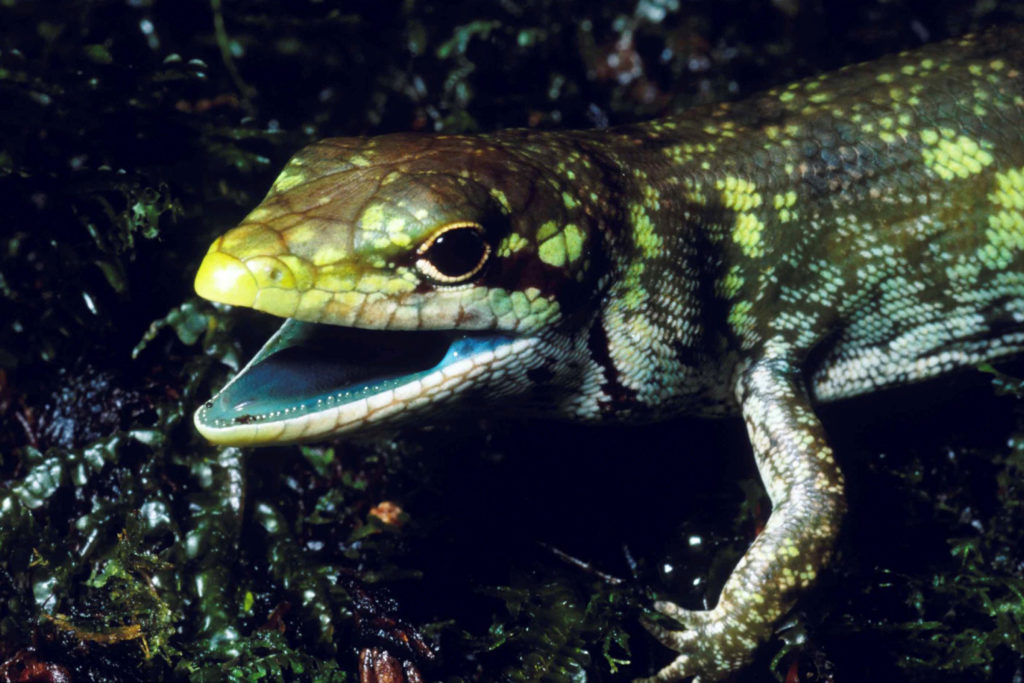Science Says: Green-blooded lizards pose evolutionary puzzle

This undated photo provided by Christopher Austin in May 2018 shows a prehensile tailed skink (Prasinohaema prehensicauda) from the highlands of New Papua New Guinea. The high concentrations of the green bile pigment biliverdin in the blood overwhelms the crimson color of red blood cells resulting in a lime-green coloration of the muscles, bones, and mucosal tissues. (Christopher Austin via AP)
WASHINGTON — For some lizards it’s easy being green. It’s in their blood. Six species of lizards in New Guinea bleed lime green thanks to evolution gone weird.
It’s unusual, but there are critters that bleed different colors of the rainbow besides red. The New Guinea lizards’ blood — along with their tongues, muscles and bones — appear green because of incredibly large doses of a green bile pigment. The bile levels are higher than other animals, including people, could survive.
Scientists still don’t know why this happened, but evolution is providing some hints into this nearly 50-year mystery.
By mapping the evolutionary family tree of New Guinea lizards, researchers found that green blood developed inside the amphibians at four independent points in history, likely from a red-blooded ancestor, according to a study in Wednesday’s journal Science Advances.
This isn’t a random accident of nature but suggests this trait of green blood gives the lizards an evolutionary advantage of some kind, said Christopher Austin of Louisiana State University.
“Evolution can do amazing things given enough time,” Austin said. “The natural world is a fascinating place.”
Austin first thought that maybe being green and full of bile would make New Guinea lizards taste bad to potential predators.
“I actually ate several lizards myself and they didn’t taste bad,” Austin said. He also fed plenty of them to a paradise kingfisher bird with no ill effects except maybe a fatter bird.
Understanding bile is probably key. Blood cells don’t last forever. After they break down, the iron is recycled for new red blood cells, but toxins are also produced, which is essentially bile.
In the New Guinea lizards, levels of a green bile pigment are 40 times higher than what would be toxic in humans. It’s green enough to overwhelm the color of the red blood cells and turn everything green, Austin said.
In people, elevated green bile pigment levels sometimes kill malaria parasites.
Austin thinks that might be why lizards evolved to be green-blooded because malaria is an issue for New Guinea and lizards. It might be the result of evolution trying to kill the malaria parasite in lizards or it might be past lizards were infected so heavily that this was the body’s reaction, he said.
The next step is to search for the specific genes involved.
Michael Oellermann, a researcher at the University of Tasmania in Australia, praised Austin’s work and wondered if there is an evolutionary cost to having green blood.
Otherwise more critters would bleed green or another color, he said.
Many insects, spiders and molluscs have the copper-containing blood pigment that’s clear unless it attaches to oxygen and then it turns blue. Squids and octopuses have intense blue blood. Icefish in Antarctica have clear blood, while little crustaceans from Lake Baikal in Siberia have blood that’s blue or red or green.
Marine worms called lamp shells have violet to pink blood, according to the American Chemical Society.
“Biology is incredibly diverse,” Austin said. /muf